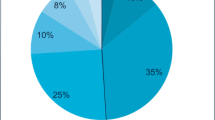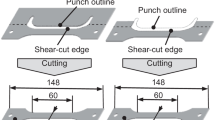Abstract
The growing demand for new steel grades, such as high formability steels and high or ultra-high strength steels for structural and safety-related automotive components, make manufacturing steel sheets an increasingly complex task. A novel hybrid process (HyP), that combines the skin-pass and tension levelling processes into one production step is proposed to improve the steel strip manufacturing chain. The HyP applies asymmetrical rolling (H-ASR) by using different roll diameters and by bending the strip before it enters the roll gap. The potential advantages of H-ASR, such as the introduction of through-thickness higher plastic deformation and the use of reduced roll force and power, were investigated by means of elastic-plastic finite element models and experimental data. The numerical models were validated by experiments at a HyP pilot facility and by industrial trials. Analytical estimation of the appropriate bending limits was included. The contact condition, material deformation and stress state during rolling were analysed and compared with the results of a conventional skin-pass process. It was verified that the proposed H-ASR introduced higher shear deformation throughout the strip thickness than a traditional skin-pass process. The positive influence of this fact was verified by tensile and formability tests on material processed by the HyP pilot facility. The results indicate that the HyP produces sheets with better drawability, satisfactory strength, and formability qualities comparable to those of the conventional finishing processes. What’s more, the HyP boasts all these advantages while using a space-saving layout and reducing energy consumption as compared to traditional finishing processes.

















Similar content being viewed by others
References
Mapelli C, Barella S, Mombelli D, Baldizzone C, Gruttadauria A (2013) Comparison between symmetric and asymmetric hot rolling techniques performed on duplex stainless steel 2205. Int J Mater Form 6(3):327–339. https://doi.org/10.1007/s12289-011-1089-9
Wiklund O, Sandberg F (2002) Modelling and control of temper rolling and skin pass rolling. In: Lenard JG (ed) Metal forming science and practice. Elsevier, Oxford, pp 313–343. https://doi.org/10.1016/B978-008044024-8/50015-1
Morris JW, Hardy SJ, Thomas JT (2002) Some fundamental considerations for the control of residual flatness in tension levelling. J Mater Process Technol 120(1–3):385–396. https://doi.org/10.1016/S0924-0136(01)01175-X
Abdelkhalek S, Zahrouni H, Potier-Ferry M, Legrand N, Montmitonnet P, Buessler P (2009) Coupled and uncoupled approaches for thin cold rolled strip buckling prediction. Int J Mater Form 2(SUPPL. 1):833–836. https://doi.org/10.1007/s12289-009-0547-0
Diegelmann V, Zwickel G, Ullrich M, Gouveia H, Weirauch U, Boguslawsky K, Pernía-Espinoza A (2013) Neues Verfahren zur unabhängigen Einstellung der mechanischen und topografischen Bandeigenschaften. Stahl und Eisen 133(11):215–222
Gorelik VS, Klimenko IV (1997) Classification and analysis of processes of plate/strip rolling with asymmetric deformation zone. Russ Metall 3:34–42
Hwang Y-M, Tzou G-Y (1997) Analytical and experimental study on asymmetrical sheet rolling. Int J Mech Sci 39(3):289–303. https://doi.org/10.1016/S0020-7403(96)00024-0
Wronski S, Bacroix B (2014) Microstructure evolution and grain refinement in asymmetrically rolled aluminium. Acta Mater 76:404–412. https://doi.org/10.1016/j.actamat.2014.05.034
Ma C, Hou L, Zhang J, Zhuang L (2016) Influence of thickness reduction per pass on strain, microstructures and mechanical properties of 7050 al alloy sheet processed by asymmetric rolling. Mater Sci Eng A 650:454–468. https://doi.org/10.1016/j.msea.2015.10.059
Yang J, Li S, Liu J, Li X, Zhang X (2017) Finite element analysis of bending behavior and strain heterogeneity in snake rolling of AA7050 plates using a hyperbolic sine-type constitutive law. J Mater Process Technol 240:274–283. https://doi.org/10.1016/j.jmatprotec.2016.10.009
Zhang SH, Zhao DW, Gao CR, Wang GD (2012) Analysis of asymmetrical sheet rolling by slab method. Int J Mech Sci 65(1):168–176. https://doi.org/10.1016/j.ijmecsci.2012.09.015
Shore D, Kestens LAI, Sidor J, van Houtte P, van Bael A (2016) Process parameter influence on texture heterogeneity in asymmetric rolling of aluminium sheet alloys. Int J Mater Form:1–13. https://doi.org/10.1007/s12289-016-1330-7
Ouali MO, Aberkane M (2008) Multiscales modeling of microstructure evolution during asymmetric cold rolling process. Int J Mater Form 1(SUPPL. 1):89–92. https://doi.org/10.1007/s12289-008-0039-7
Cai M, Wei X, Rolfe B, Hodgson PD (2015) Microstructure and texture evolution during tensile deformation of symmetric/asymmetric-rolled low carbon microalloyed steel. Mater Sci Eng A 641:297–304. https://doi.org/10.1016/j.msea.2015.06.062
Ma R, Wang L, Wang YN, Zhou DZ (2015) Microstructure and mechanical properties of the AZ31 magnesium alloy sheets processed by asymmetric reduction rolling. Mater Sci Eng A 638(0):190–196. https://doi.org/10.1016/j.msea.2015.03.093
Toth LS, Beausir B, Orlov D, Lapovok R, Haldar A (2012) Analysis of texture and R value variations in asymmetric rolling of IF steel. J Mater Process Technol 212(2):509–515. https://doi.org/10.1016/j.jmatprotec.2011.10.018
Hamad K, Chung BK, Ko YG (2014) Microstructure and mechanical properties of severely deformed mg–3%al–1%Zn alloy via isothermal differential speed rolling at 453 K. J Alloys Compd 615(Supplement 1(0)):S590–S594. https://doi.org/10.1016/j.jallcom.2013.12.195
Duan Y, Xu G, Tang L, Liu Y, Xu J, Deng Y, Yin Z (2017) Excellent high strain rate superplasticity of al-mg-Sc-Zr alloy sheet produced by an improved asymmetrical rolling process. J Alloys Compd 715:311–321. https://doi.org/10.1016/j.jallcom.2017.04.273
Li S, Qin N, Liu J, Zhang X (2016) Microstructure, texture and mechanical properties of AA1060 aluminum plate processed by snake rolling. Mater Des 90:1010–1017. https://doi.org/10.1016/j.matdes.2015.11.054
Guo X, Deng Y, Zhang Y, Zhang J, Zhang X (2017) Microstructure and microtexture evolution of shear bands in al–cu single crystal during asymmetric rolling. Mater Charact 128:37–42. https://doi.org/10.1016/j.matchar.2017.03.022
Nakhoul R, Montmitonnet P, Legrand N (2015) Manifested flatness defect prediction in cold rolling of thin strips. Int J Mater Form 8(2):283–292. https://doi.org/10.1007/s12289-014-1166-y
Kijima H, Bay N (2007) Contact conditions in skin-pass rolling. CIRP Ann Manuf Technol 56(1):301–306. https://doi.org/10.1016/j.cirp.2007.05.070
Szucs M, Krallics G, Lenard JG (2017) The stribeck curve in cold flat rolling. Int J Mater Form 10(1):99–107. https://doi.org/10.1007/s12289-015-1263-6
Escribano R, Lostado R, Martínez-de-Pisón FJ, Pernía A, Vergara E (2012) Modelling a skin-pass rolling process by means of data mining techniques and finite element method. J Iron Steel Res Int 19(5):43–49. https://doi.org/10.1016/S1006-706X(12)60098-3
Marciniak Z, Duncan JL, Hu SJ (2002) 10-Combined bending and tension of sheet. In: Mechanics of sheet metal forming, 2nd edn. Butterworth-Heinemann, Oxford, pp 136–151. https://doi.org/10.1016/B978-075065300-8/50013-3
Roberts J, Sheppard T (1971) On the mechanics of the tension-levelling process. J Inst Met 99:293–301
Byrd RH, Lu PH, Nocedal J, Zhu CY (1995) A limited memory algorithm for bound constrained optimization. SIAM J Sci Comput 16(5):1190–1208. https://doi.org/10.1137/0916069
Montgomery D (2001) Design and analysis of experiments, 5th edn. John Wiley and Sons, INC., New York
Corporation DSS (2011) ABAQUS User’s Manual 6.11. Providence
Banabic D (2007) Advanced methods in material forming.Springer-Verlag Berlin Heidelberg Berlin. https://doi.org/10.1007/3-540-69845-0
Sun J-N, Huang H-G, Du F-S, Li X-T (2009) Nonlinear finite element analysis of thin strip temper rolling process. J Iron Steel Res Int 16(4):27–32. https://doi.org/10.1016/S1006-706X(09)60056-X
Kijima H (2013) Influence of roll radius on contact condition and material deformation in skin-pass rolling of steel strip. J Mater Process Technol 213(10):1764–1771. https://doi.org/10.1016/j.jmatprotec.2013.04.011
Hao L, Di H-S, Gong D-Y (2013) Analysis of sheet curvature in asymmetrical cold rolling. J Iron Steel Res Int 20(5):34–37. https://doi.org/10.1016/S1006-706X(13)60094-1
Beik HAA, Dehghani K (2008) Irregularity in friction hills during the cold rolling of materials. Int J Mater Form 1(SUPPL. 1):343–346. https://doi.org/10.1007/s12289-008-0065-5
Kobayashi S, Oh S, Altan T (1989) Metal forming and the finite-elemet method. Oxford series on advanced manufacturing. Oxford University Press, New York
Liu Z, Wang Y, Yan X (2012) A new model for the plate leveling process based on curvature integration method. Int J Mech Sci 54(1):213–224. https://doi.org/10.1016/j.ijmecsci.2011.10.011
Lapovok R, Orlov D, Timokhina IB, Pougis A, Toth LS, Hodgson PD, Haldar A, Bhattacharjee D (2012) Asymmetric rolling of interstitial-free steel using one idle roll. Metall Mater Trans A Phys Metall Mater Sci 43(4):1328–1340. https://doi.org/10.1007/s11661-011-0960-0
Hill R (1952) On discontinuous plastic states, with special reference to localized necking in thin sheets. J Mech Phys Solids 1(1):19–30. https://doi.org/10.1016/0022-5096(52)90003-3
Acknowledgements
The authors would like to express their gratitude for the financial support provided by the European Union, under the RFCS project reference RFSR-CT-2007-00016, which has made this research possible. Special thanks to U. Weirauch Engr. and K. Boguslawsky Engr., both from Andritz Sundwig GmbH (Hemer, Germany), for their invaluable dedication in building the HyP pilot facility and for their subsequent assistance. The authors would also like to thank G. Zwickel Engr. and M. Ullrich Engr., both from Bilstein Group GmbH (Hagen, Germany), for providing the extremely valuable skin-pass process experimental data. We would also like to express our gratitude to H. Gouveia PhD. from ISQ (Porto Salvo, Portugal) for the tests conducted on the processed materials. One of the authors (JFC) would also like to acknowledge the University of La Rioja for the FPI fellowship program. Finally, we would like to add that this work used the Beronia cluster (Universidad de La Rioja), which is supported by FEDER-MINECO grant number UNLR-094E-2C-225.
Funding
This study was funded by the European Union, under the RFCS project reference RFSR-CT-2007-00016.
Author information
Authors and Affiliations
Corresponding author
Ethics declarations
Conflict of interest
The authors declare that they have no conflict of interest.
Rights and permissions
About this article
Cite this article
Pernia-Espinoza, A., Diegelmann, V., Escribano-Garcia, R. et al. A novel hybrid strip finishing process to improve mechanical properties and reduce energy consumption. Int J Mater Form 12, 27–43 (2019). https://doi.org/10.1007/s12289-018-1403-x
Received:
Accepted:
Published:
Issue Date:
DOI: https://doi.org/10.1007/s12289-018-1403-x




